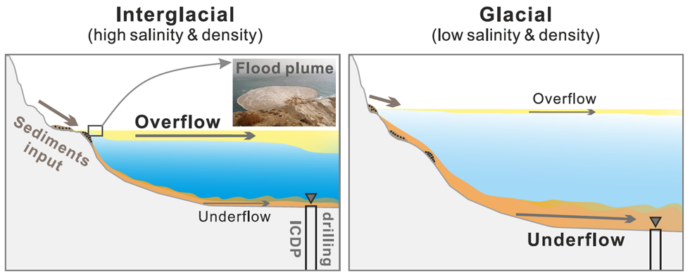I am on my way back from the PATA Days in France, which were great. A detailed report will follow later. In the meantime, enjoy reading the latest papers – we have a nice variety of topics and working areas.
more-
New papers on paleoseismology, active tectonics, and archaeoseismology (Oct 2022)
-
PATA Days programme and short abstracts available
2022-09-23 | in PATA daysThe PATA Days in France are just a few days away. Get in the right mood by checking out the programme or by reading the (short) abstracts. The field trip guide for the post-conference excursion is also available for download here. The official website has all the important news concerning logistics etc.: https://patadays-2022.sciencesconf.org/
See you all in Southern France!
-
Likelihood of primary surface faulting – spoiler of a PATA Days poster
The Aix-en-Provence PATA Days are fast approaching and the meeting programme looks super-exciting! Unfortunately, I’ll not attend the congress, but my soul will be there in poster form – presenting author is 1st year PhD student Marco Pizza and the topic is the likelihood of primary surface faulting.
Some earthquakes produce surface faulting, others do not. Several factors affect the outcome of this dichotomous variable (faulting YES/NO), including magnitude, depth, earthquake kinematic and local lithology. The probability of having surface rupture for a given magnitude is a key ingredient in Fault Displacement Hazard Assessment (FDHA). This probability is derived from empirical datasets and the state of the art is summarized in Figure 1, taken from the recently published IAEA Tecdoc on probabilistic FDHA.
Continue reading -
New papers on paleoseismology, active tectonics, and archaeoseismology (Sep 2022)
-
Christoph Grützner
New papers on paleoseismology, active tectonics, and archaeoseismology (Aug 2022)
-
Insights into sediment flow processes can help to better understand the feasibility of turbidite as an earthquake indicator in a specific subaqueous environment
2022-07-23 | in Paper
We investigated homogeneous muds, turbidites, and debrites that were preserved in a 457-m deep ICDP drilling (220-0 ka) from the Dead Sea depocenter. Based on previous flash flood measuring, surface plume monitoring, and sediment traps monitoring in the lake center, we link homogeneous muds in the deep core to overflows, and link turbidites and debrites to underflows. The study bridges the gap between our understanding of modern sediment density flow processes and deposits preserved in a long-term geological record in the Dead Sea, a tectonically active subaqueous environment (Dead Sea rift zone).
more -
New papers on paleoseismology, active tectonics, and archaeoseismology (July 2022)
2022-07-04 | in Paper | one responseThis time I found a lot of studies on tsunamis, including a whole book on tsunamis that affected the Iberian Peninsula. Then there’s classical paleoseismology of course and tectonic geomorphology, but also some discussion on science communication and news about earthquakes in the European Alps. Enjoy reading!
more -
Inqua Rome 2023 congress: abstract submission is open!
2022-06-28 | in MeetingThe XXI Inqua congress will take place in Rome in July 2023. Don’t forget to submit your abstract, deadline is November 1st, 2022! Submit your abstract here
Below are some highlights on sessions centered on earthquakes, active faulting and tectonic stuff, but remember to check the full list – 209 proposed sessions!
Keep on reading! -
New papers on paleoseismology, active tectonics, and archaeoseismology (June 2022)
2022-06-01 | in PaperAs Francesca has reported in her latest post, a lot of trenching is currently going on all around the world. Here you can read about previous trenching results that have now made it through review. Enjoy reading and have a great field season!
more -
Trenching season is ongoing!
2022-05-20 | in Field work, Opinion | 2 responsesFollowing an un-systematic post-dinner doomscrolling I’m happy to declare May 2022 as the trenchiest month ever. Here’s some exhibits:
Safety first; if cozy and comfy it’s better.
The award goes to Stéphane Baize (@Stef_EQ_Geology) and their trenches along the Cévennes fault: look at the details in the photo… like “paleo” engraved in the wooden frame to prevent collapse of the trench wall. And what about the tent? 10/10 professional style.
Landscape photography award
The winner is Colca Canyon in Southern Peru, take a look at the pictures by Anderson Palomino (@AndersonRPT1) and Carlos Benavente (@clbenavente)
Best flower structure award
No doubts here, easy win for Ian Pierce (@neotectonic) and their trenches in Azerbaijan. Follow him for stunning field photos and videos.
Mud club
Mention goes to Jade Humprey (@ForFaultsSake).
The tricks of the trade.
Learn them from Jonathan Obrist-Farner (@guateologist) uncovering the mysteries of the 1976 Motagua rupture in Guatemala
Category “You don’t need a trench to find good stratigraphy”.
Prize goes to Gabriel Easton Vargas (@geastonvargas) and paleotsunami research in semiarid Chile
Category “Let’s the student do the work”.
Terrific exhibit by Shreya Arora (@shryaarora) trenching in the Himalaya region
Never without a nijiri gama.
Award is won by Sambit Prasanajit (@SPrasanajit) and their sites in S. Korea
Fancy fence
The winner is PhD student Argelia Silva Fragoso (@Argy_sf) from Insubria university, digging trenches in Central Italy
Sorry if I missed someone, I wish you all a safe and fruitful field season!

